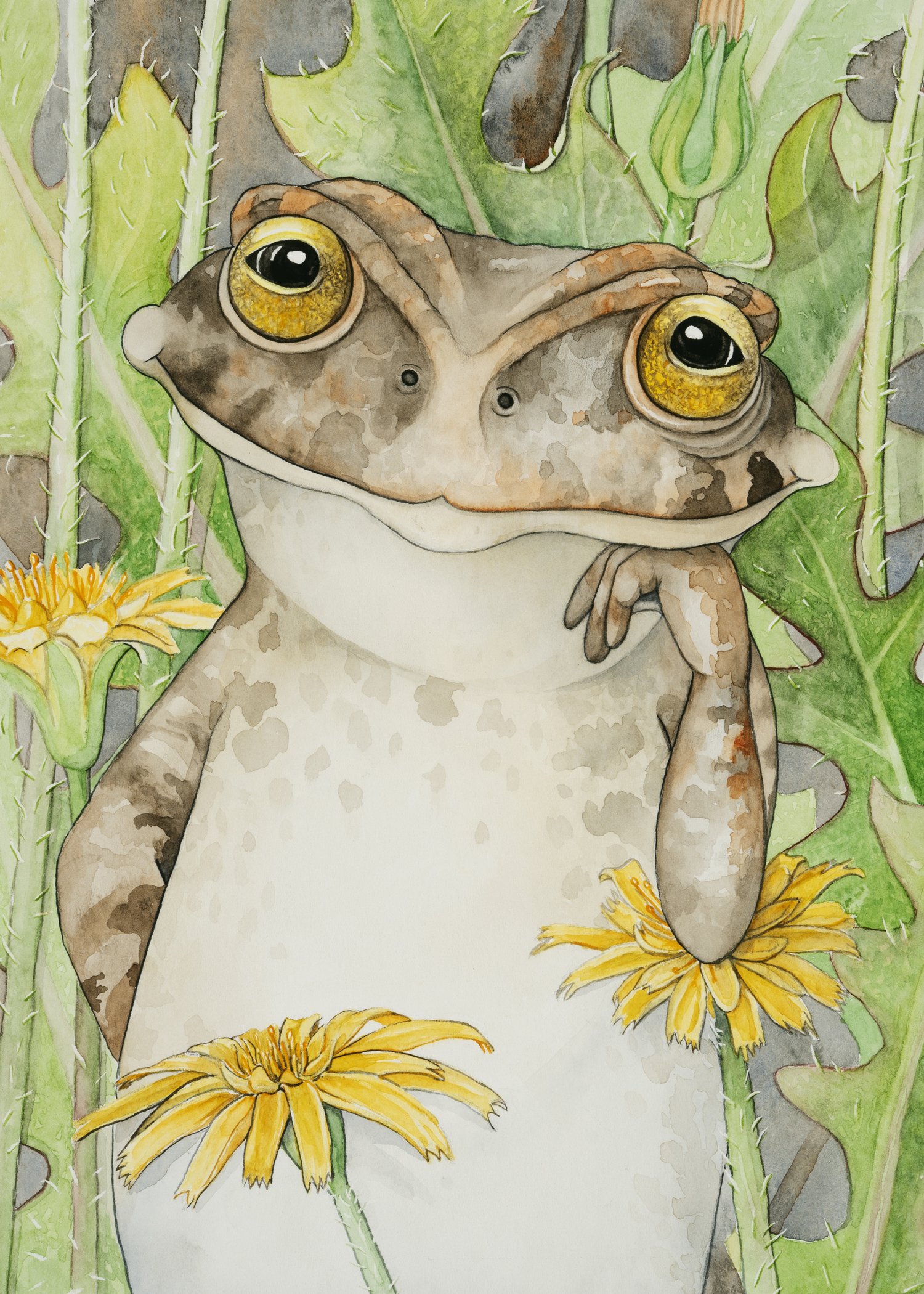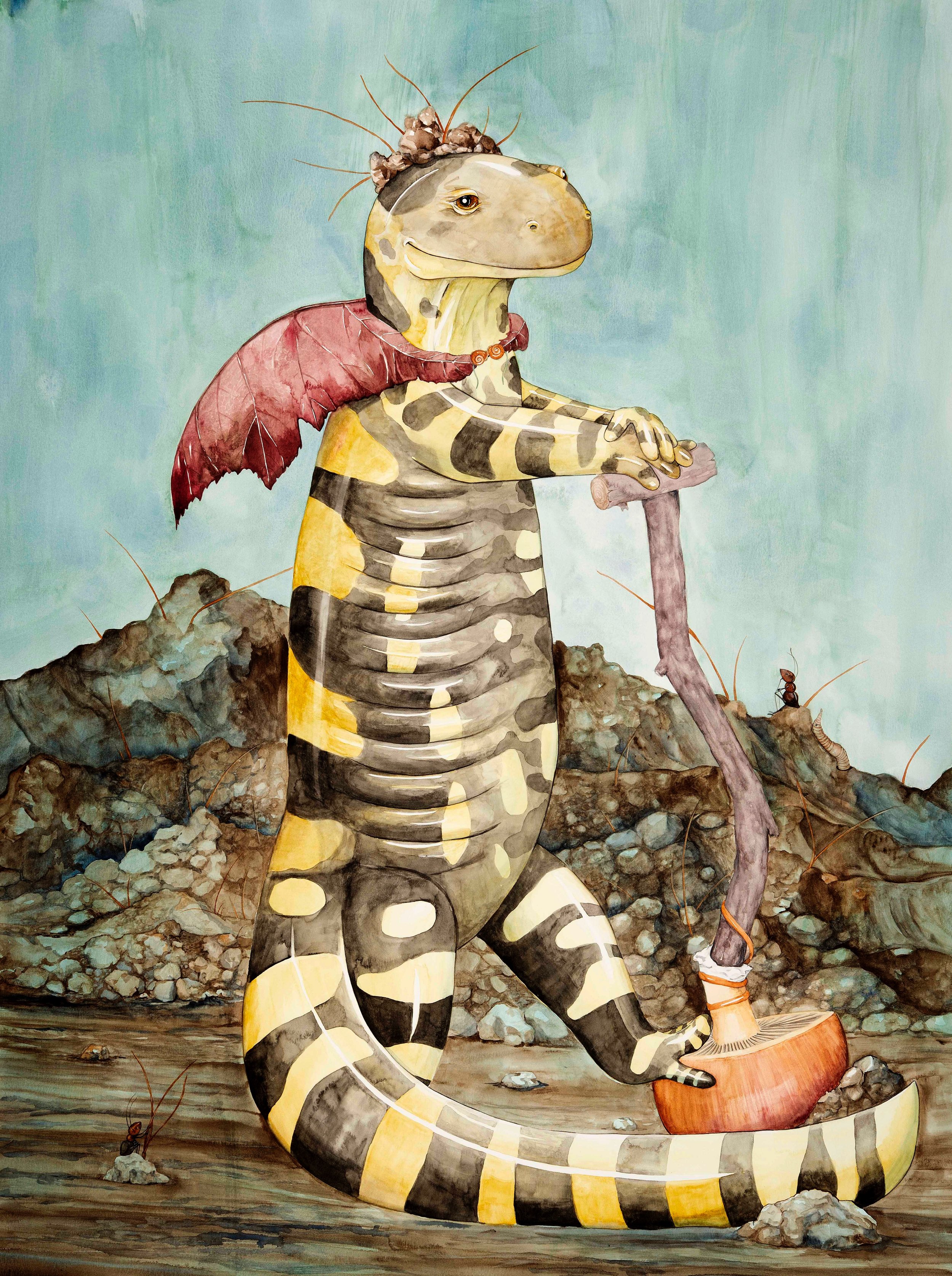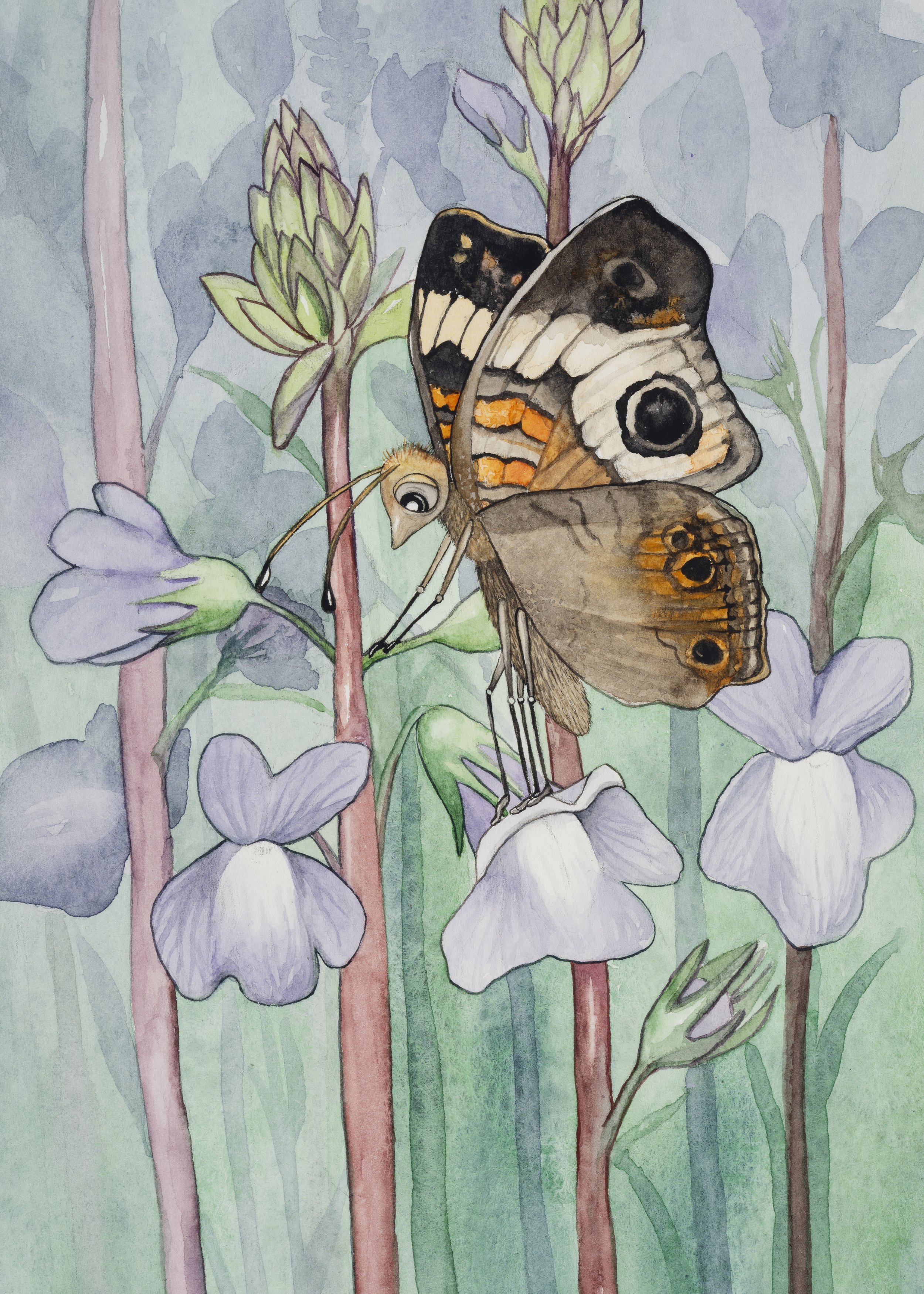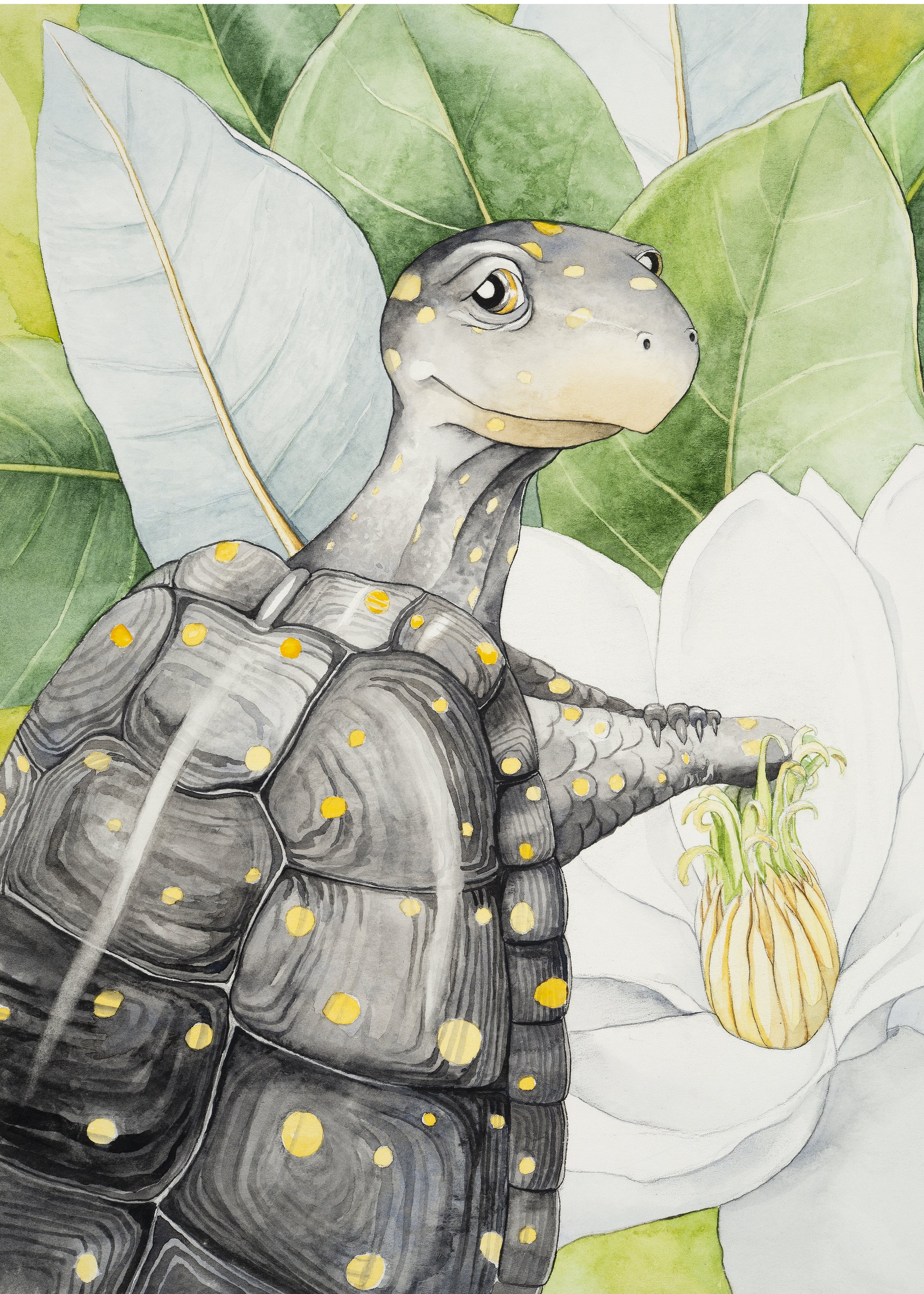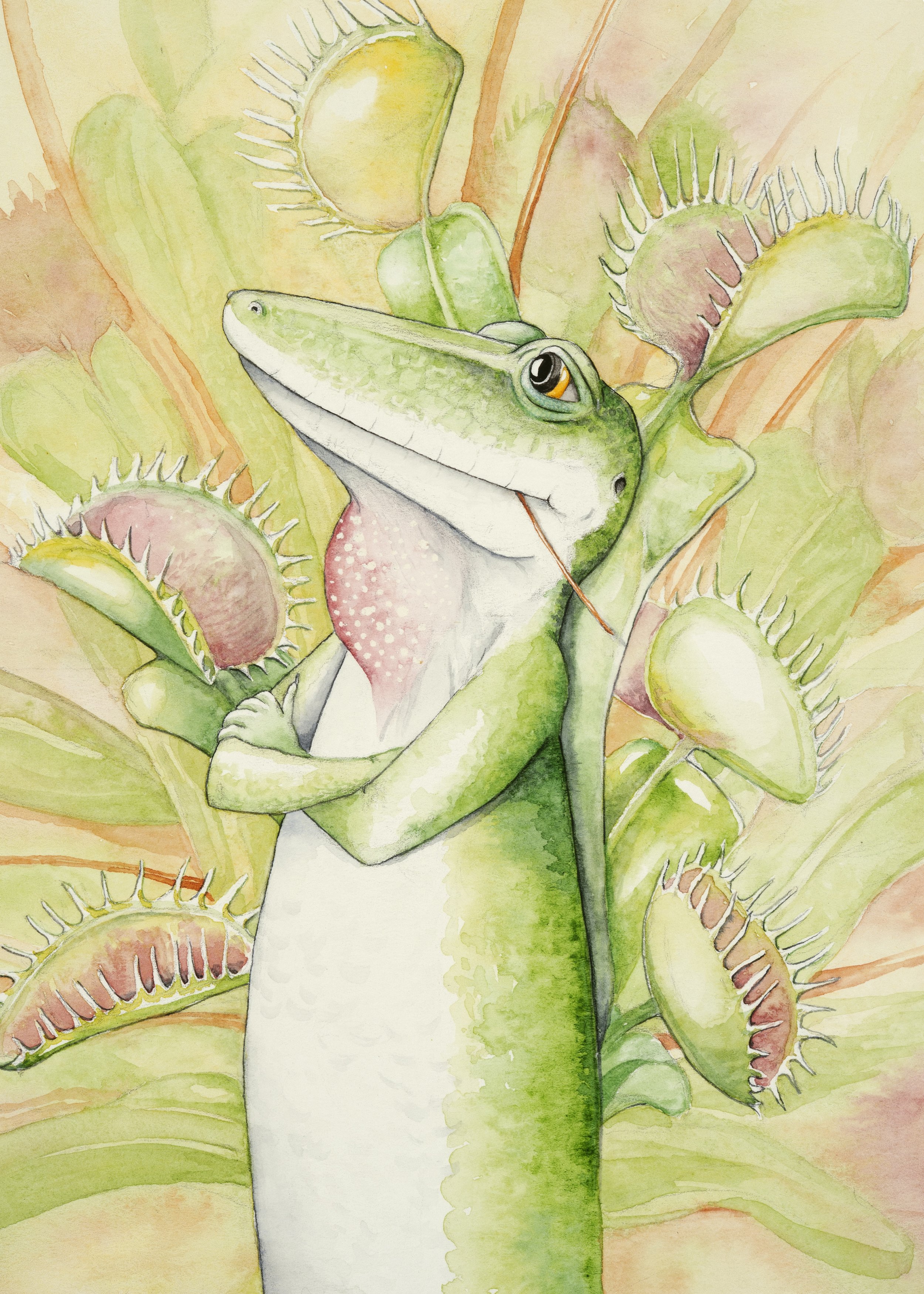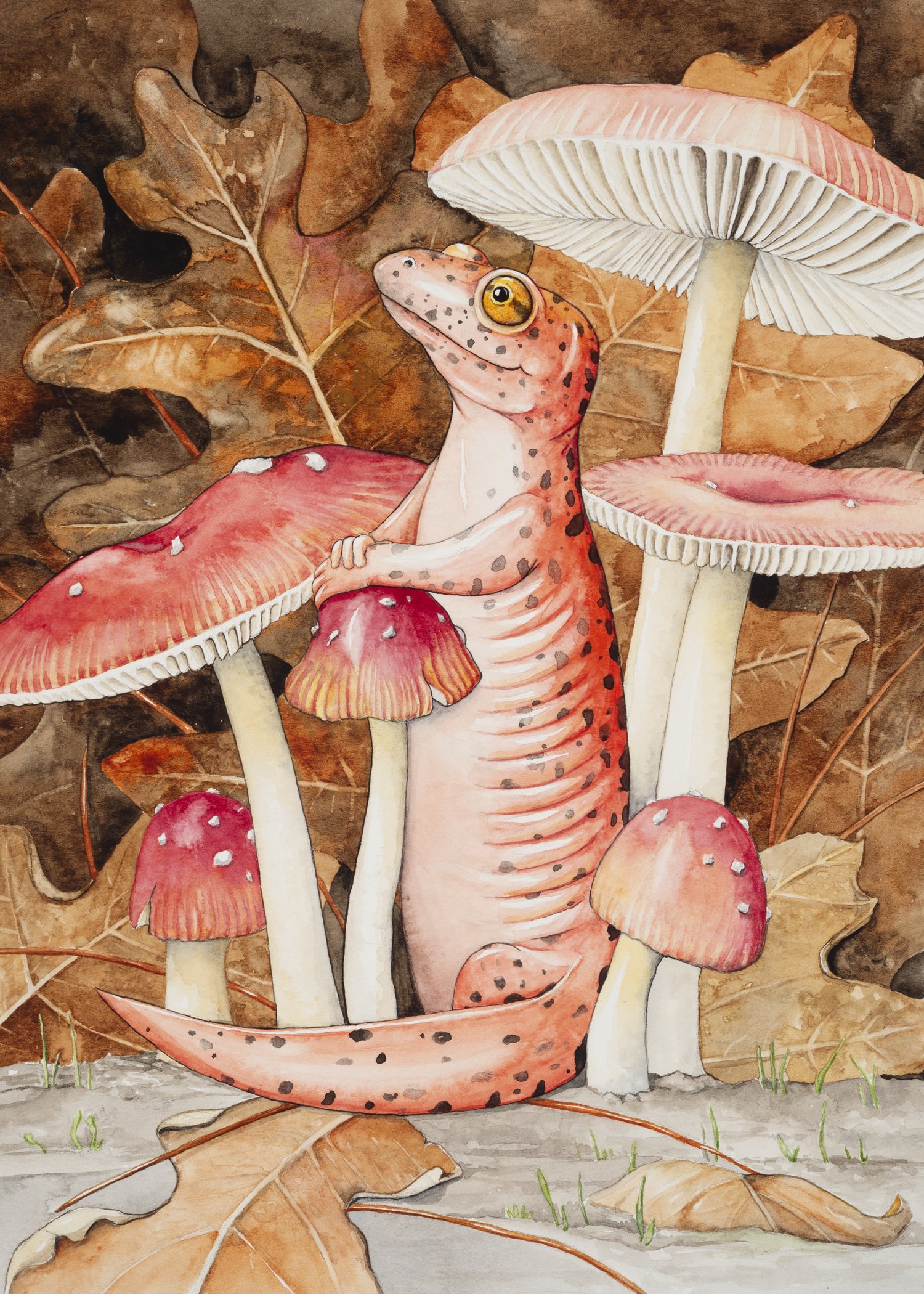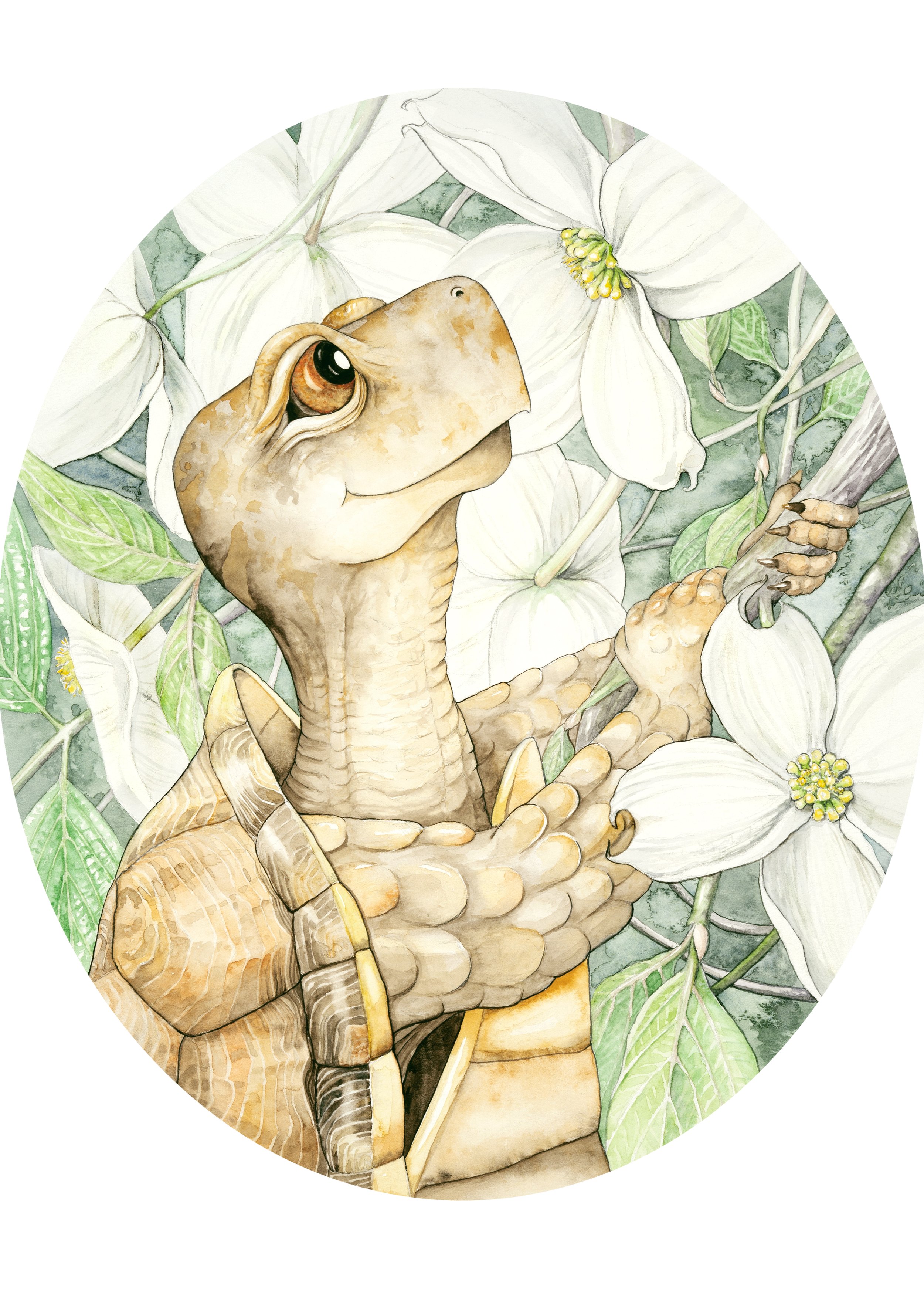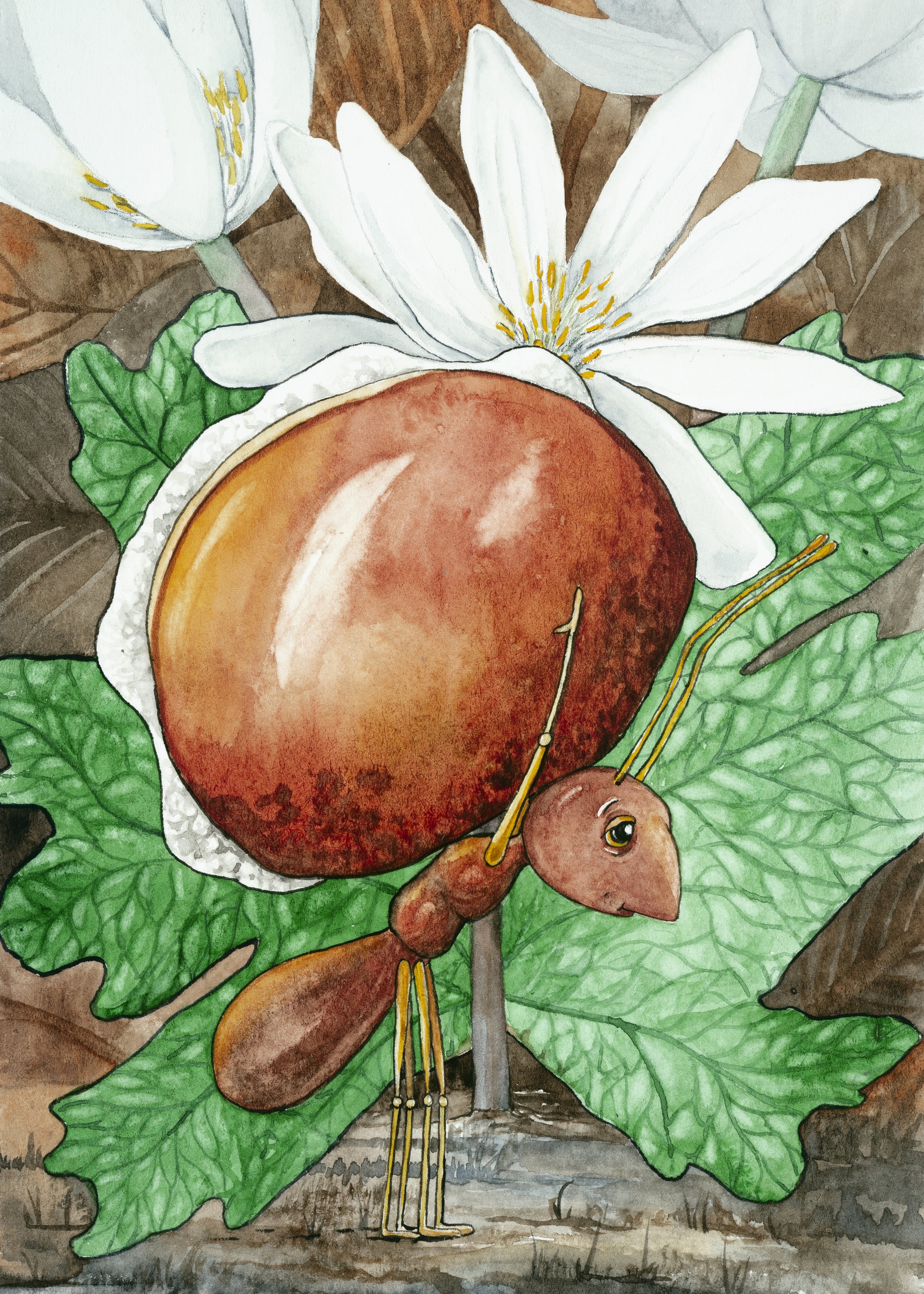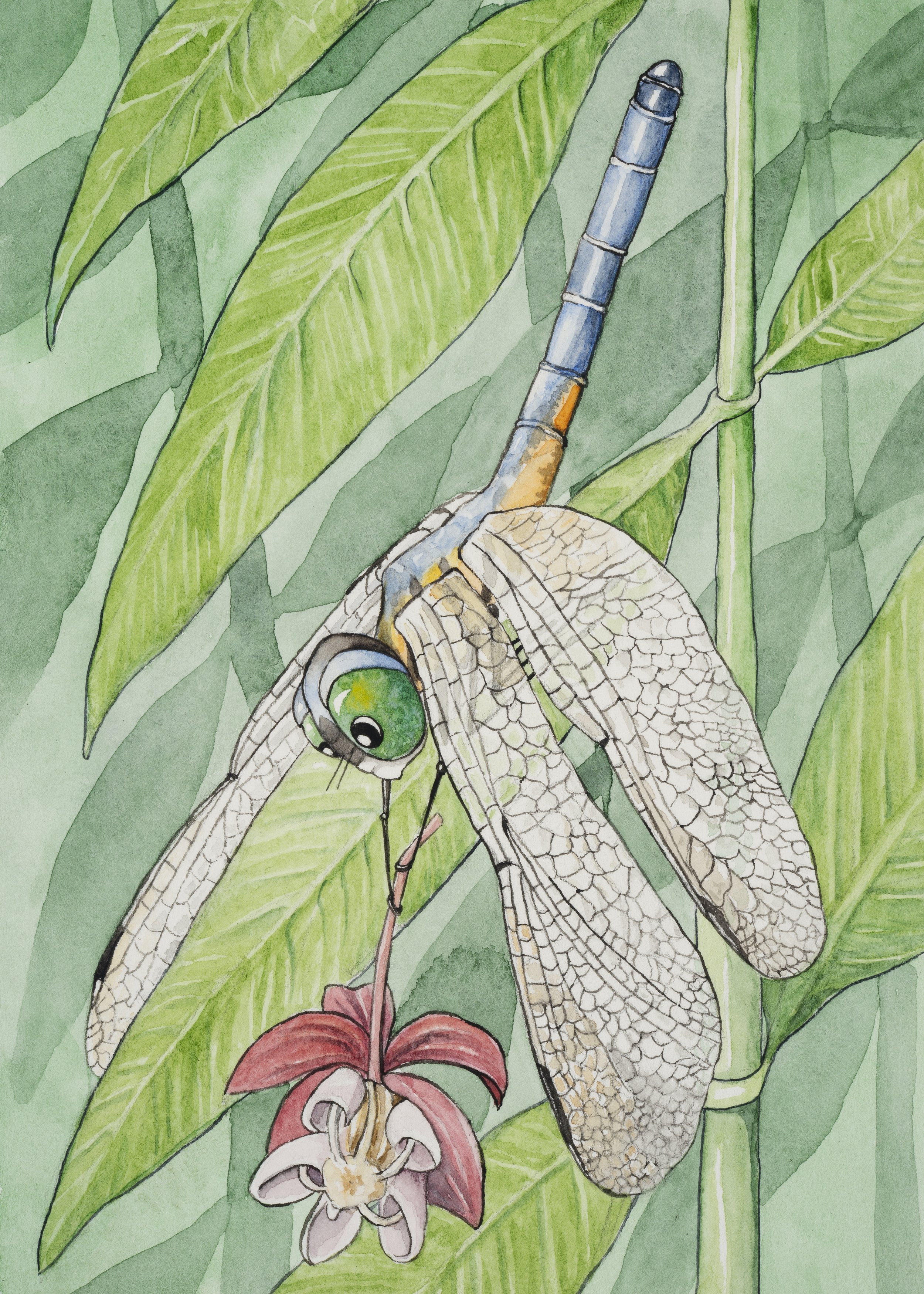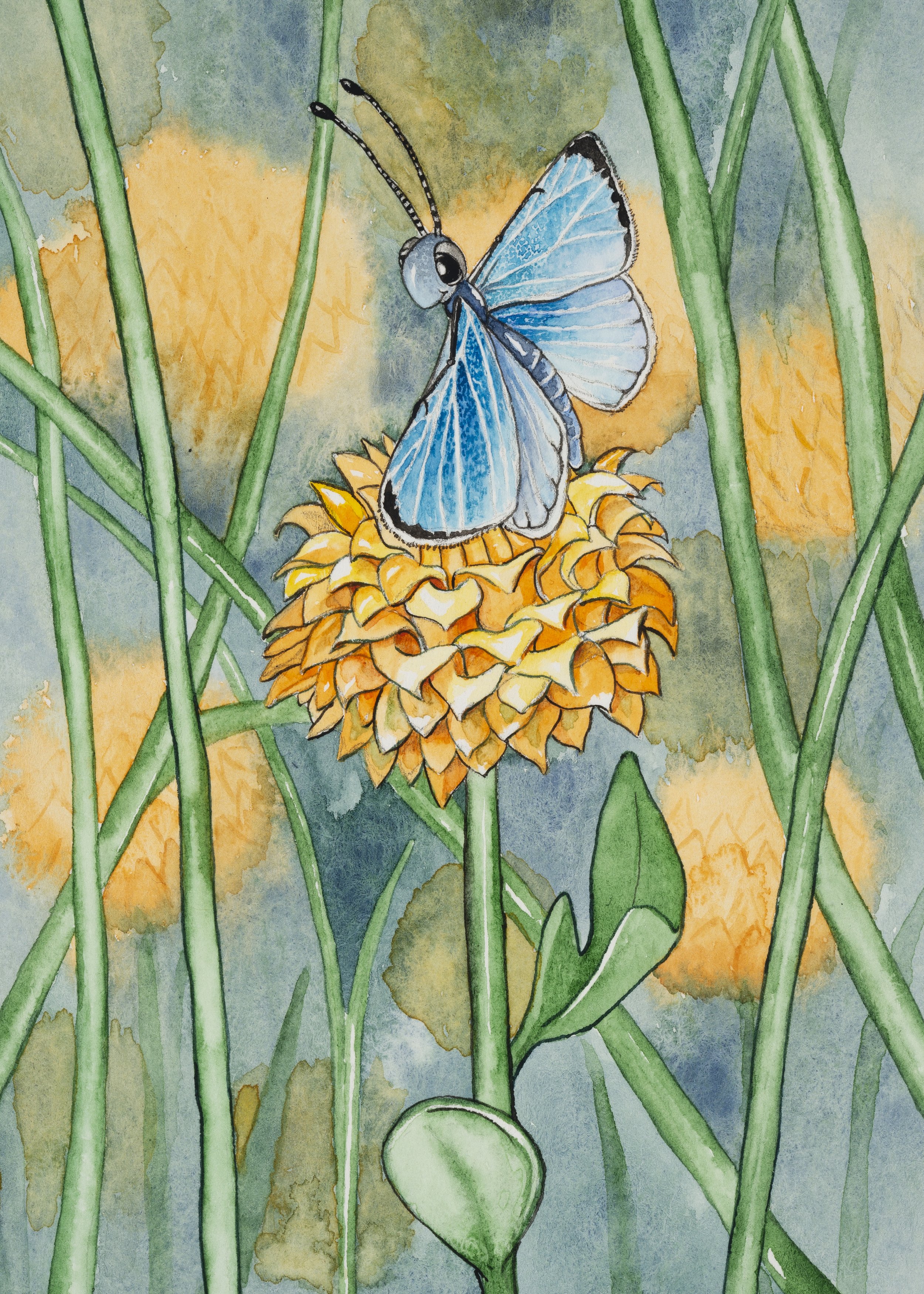
The Whimsical Naturalist
This traveling exhibition combines whimsical narrative portraits with scientific discovery. Each watercolor portrait is a native North Carolina animal paired with a native plant found in that animal’s environment. Each species is rendered with identifying characteristics as well as expressive character development. Each painting comes with a fun informational description of the species and their connections."The Whimsical Naturalist" is a engaging world that people can step into! A world where nature's wonders and realities are emphasized through anthropomorphism, shifting perspectives and scientific knowledge. I hope people will walk in, smile, learn and leave thinking about how we are connected to our environment and each other.
For information on hanging this traveling exhibition please feel free to contact me! This is only a representative sampling. There are over 50 different pieces in the show. Can be hung as a whole or in part.
Southern Toad Bufo (Anaxyrus) terrestris With Dwarf Virginia Dandelion Krigia virginica This Southern Toad was a delightful and charming subject as their name might imply. They gifted me their favorite flower, the Dwarf Virginia Dandelion. This is the smallest native Dandelion species and found throughout the Southern Toad’s range. Southern Toads reside in the Eastern part of NC and can be the only large toad living in parts of the lower coastal plain. They like to dine on many types of bugs, beetles, worms and other tasty and refined invertebrates. Sometimes waiting patiently for them to wander by other times actively hunting them at night. They are very proud of their pronounced cranial crests, the main way to tell Southern Toads from other varieties. Although they are known to hybridize with other toad species making identification difficult where territories overlap.
Eastern Box Turtle Terrapene carolina carolina With Dogwood Cornus florida The eastern box turtle is common across the state. It is the only terrestrial turtle in NC and is recognizable because of its ability to “box up” its shell for protection. They are mobile critters with homing instincts and establish ranges that include their favorite foods, hidey holes and meet up locations. They can live 25-30 years in the wild which puts them in danger from habitat fragmentation. This box turtle was showing me it’s favorite Flowering Dogwood tree. It was very proud to have NC’s state flower growing on its property. They told me dogwood flowers and rootbark were used as medicines by Native Americans, but to avoid the berries as they are toxic to people. The dogwood is an important part of the forest understory providing food for wildlife and improving soil quality because its leaves decompose quickly.
Hoary Bat Lasiurus cinereus With Black Locus Tree Robinia pseudoacacia and Salt Marsh Moth Estigmene acrea Meet NC’s largest and arguably most adorable pest control on wings. This Hoary Bat, named Horatio, knows that bats tend to be associated with darkness, horror, and creepiness. He completely disavows this image, insisting that I tell the true story of bats! Hoary bats, along with the other 16 species of NC bats are responsible for eating thousands of TONS of insects a year. They are the only major predator of night flying insects, bringing environmental balance to the dark. Hoary bats primarily eat moths with lots of other bugs mixed in for spice. Horatio and these two Salt Marsh Moths have called a truce in order to work on both of their public images. Horatio didn’t outright admit it but I believe he also has an appreciation for the serene and beautiful. Hoary Bats are highly migratory and mostly seen in the Western part of NC during the warmer months. This also happens to be when the Black Locus trees, native to the mountains of NC, bloom. Hoary bats only roost in trees, specifically in the lower branches near forest edges. There are also studies that shows northern bats prefer black locus trees over others. Is it just a coincidence or do bats appreciate a good roosting tree with beautiful flowers?
Eastern Tiger Salamander Ambystoma tigrinum With Dirt Meet Sally the Eastern Tiger Salamander. I was honored to paint her portrait as tiger salamanders very rarely make an appearance outside their burrows. Tiger salamanders unlike most other salamanders dig their own burrows and are subterranean most of the time. She was in the middle of digging a burrow and wanted to show off her impressive dirt pile. She is the largest of the terrestrial salamanders in the world and as such was the spokesmander for the group. Telling me proudly that NC has the largest diversity of salamanders in the world! Salamanders are amphibians. This means, like frogs, they need water sources to reproduce. NC has a large diversity of habitats, mild temperatures and overall moist conditions which salamanders need. Many of the species are found in only tiny populations making them very special and in need of consideration in our human interactions with the natural world.
Southern Wood Cricket Gryllus fultoni On Fly Agaric Mushroom Amanita muscaria Crickets are considered lucky by some cultures and have been kept as revered pets. The Southern Wood Cricket (which is actually a type of field cricket) likes to live in more wooded habitats vs. open fields. It is sitting on the magical “Fly Agaric” mushroom. These are the amanita mushrooms of the European fairy tales! And they are native in NC too! Found in many kinds of woodlands they were historically broken up into milk and used for insecticides, hence the name. But don’t worry about the cricket, it’s just using it as a place to rest and relax!
Marbled Salamander Ambystoma opacum With Hickory Leaves Carya ovata The Marbled Salamander is a smaller member of the Mole Salamander Family. A group of salamanders so named because they spend much of their time digging and burrowing underground. The marbled salamander tends to prefer moist forests and don’t stray too far from water. This one in particular was found under a hickory tree and wanted to pose with the beautiful yellow autumn leaves characteristic of hickories. Fall is also breeding time for these stripped beauties and I think they were hoping the pretty leaves would set off their stripes nicely! Marbled Salamanders are more dry tolerant than other salamanders but still rely on moisture and “ephemeral pools” for breeding. These are seasonal wetlands that come and go but are key factors in amphibian survival. As such Marbled Salamanders are use their title as NC’s State Salamander to be outspoken proponents of habitat preservation!

Each painting is framed in an antique frame! I sourced each frame, most of which are Victorian, from antique stores in NC and VA. The cohesive framing makes for a transformative and immersive show.
Dung Beetle of the Canthon Family With Poo Meet the King Tumble Turd of the Canthon family of the beetles of Dung. This family is the ball rolling branch of the dung beetle lineage (not to be confused with the poo tunnelers or dwellers) with a long and distinguished pedigree going back to the ultimate “King Tumble Turd” described by the 17th century NC naturalist Mark Catesby saying “tho’ by what appears they assume no preeminence, but without distinction partake of the like dirty drudgery with the rest.” . Dung Beetles are the ultimate recyclers of the insect world. Although to be fair, a lot of insects are great improvers of the environment. Dung beetles clear away manure, improve soil quality by adding nutrients and aeration, and compete with flies for resources.
Hellbender Cryptobranchus alleganiensis With Yellowroot Xanthorhiza simplicissima This painting in particular is about paying attention to the animals in our environment and appreciating what we have! Hellbenders are great at camouflage, so often not seen in real life. But they are indicative of healthy water systems...and have been disappearing. As a bit of a play on symbols this Hellbender wanted to be painted with a version of a reflective belt made from Yellowroot. A reflective belt’s sole purpose is to protect the wearer by making them visible. It’s not a magic shield. If those around still don’t pay attention it’s not going to help! We need these creatures and they need us to pay attention.
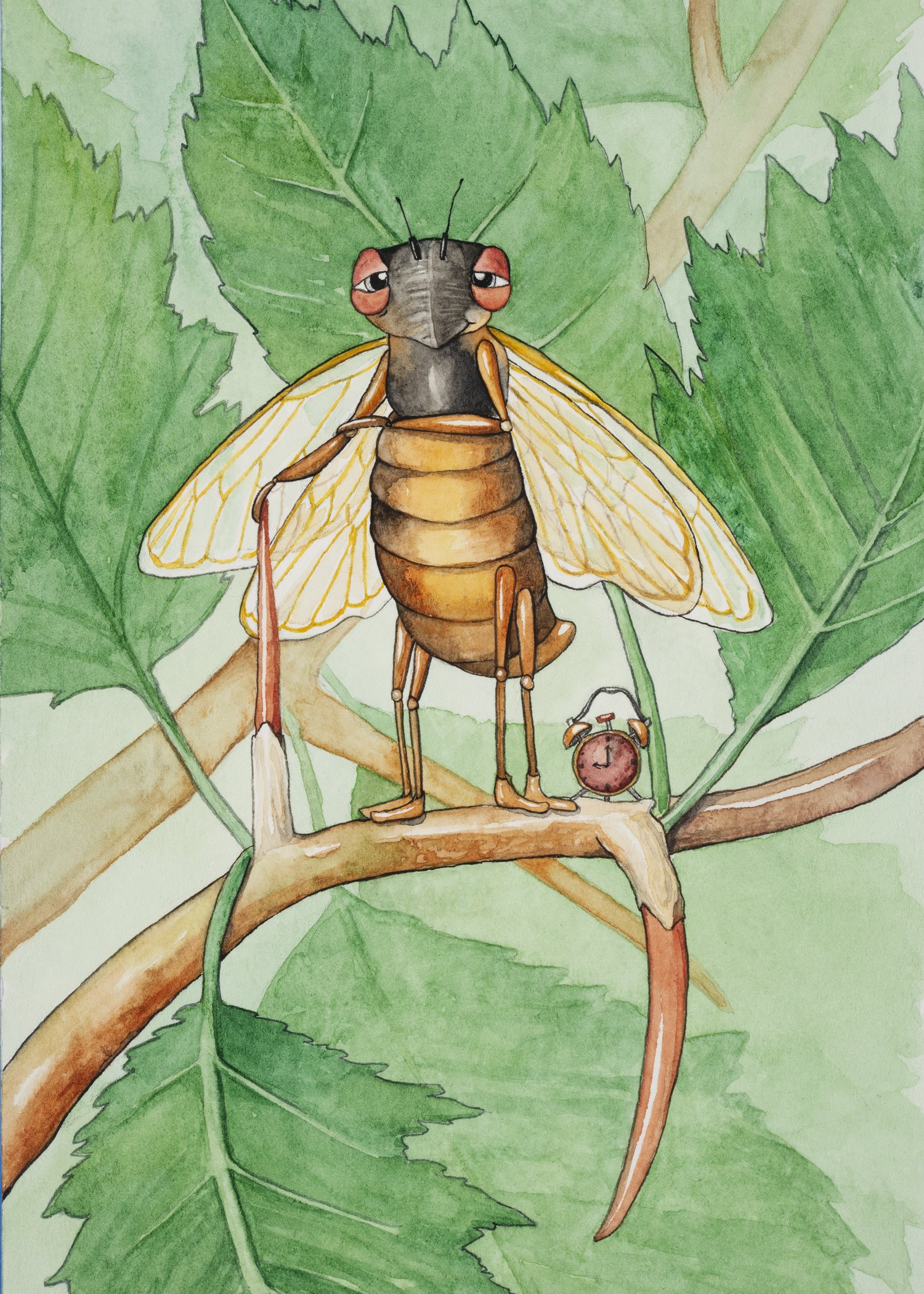
Periodic Cicada Magicicada septendecim On Fanleaf Hawthorn Crataegus macrosperma Description Available
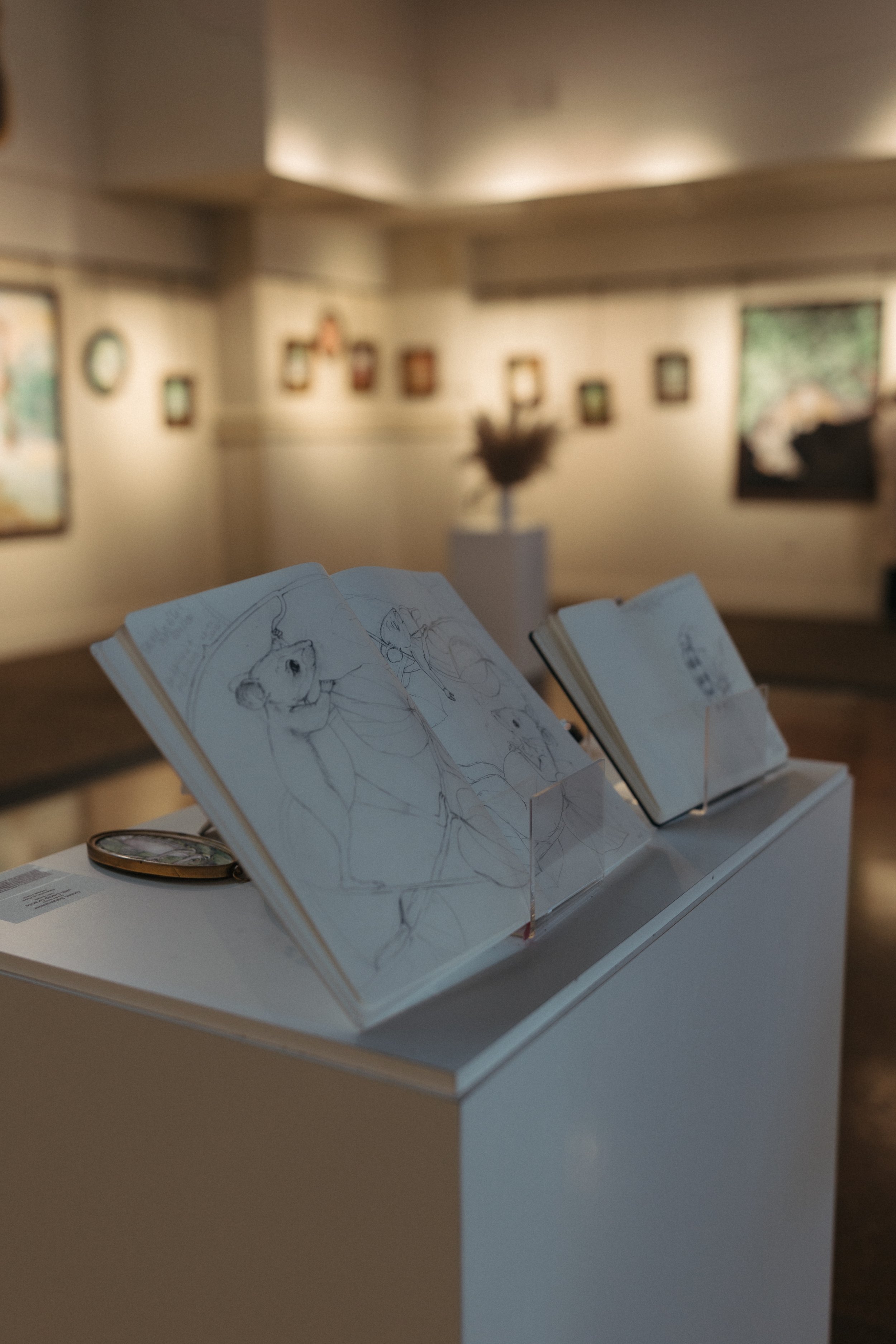
My sketch books are also available for exhibition. Displaying the sketch books adds an element of scientific and artistic discovery to the show.
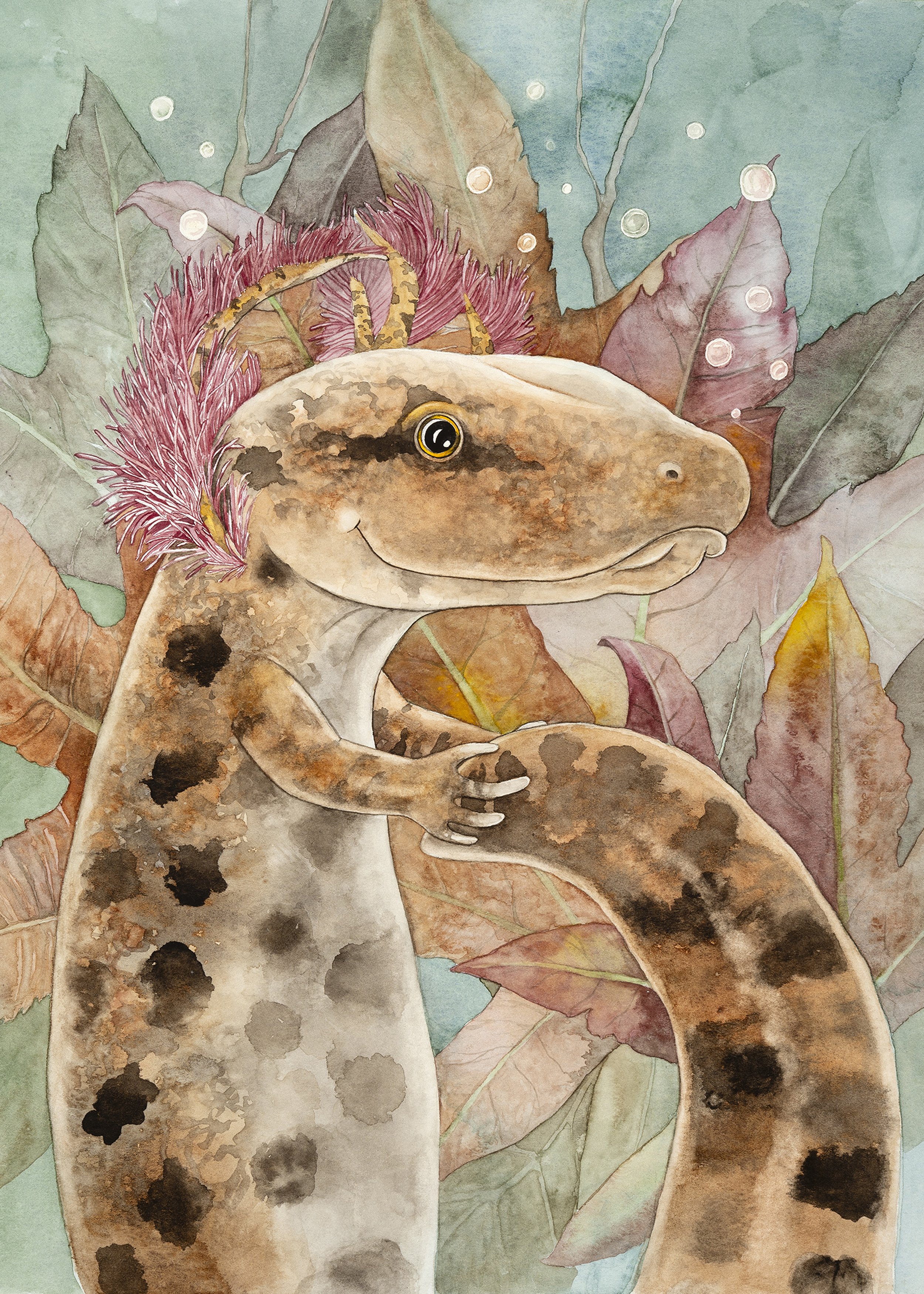
Neuse River Waterdog Necturus lewisi With American Sweet Gum Leaves Liquidambar styraciflua Description Available
Common Buckeye Junonia coenia On Toad Flax Nuttallanthus canadensis Description Available
Cope’s Grey Tree Frog Hyla chrysoscelis In Yellow Pitcher Plant Sarracenia flava Description Available
Carolina Mantid Stagmomantis carolina On Black Raspberry Canes Rubus occidentalis While many of the mantids we see are not native, there is one NC native mantis. The Carolina Mantid. Its faceplate is rectangular not square. This Mantis was more worried about me capturing the beautiful flower and its spiffy attire than analyzing the shape of its faceplate. The propensity of female mantids to eat the heads of their male mates is well known. This happens only rarely however with Carolina Mantids. So this hopeful guy brought flowers and dressed up to make the best impression he could. Every little bit helps. Mantids hunt in a number of different plant habitats but they are often found around flowering plants.
Spotted Turtle Clemmys guttata With Sweet Bay Magnolia Magnolia virginiana Description Available
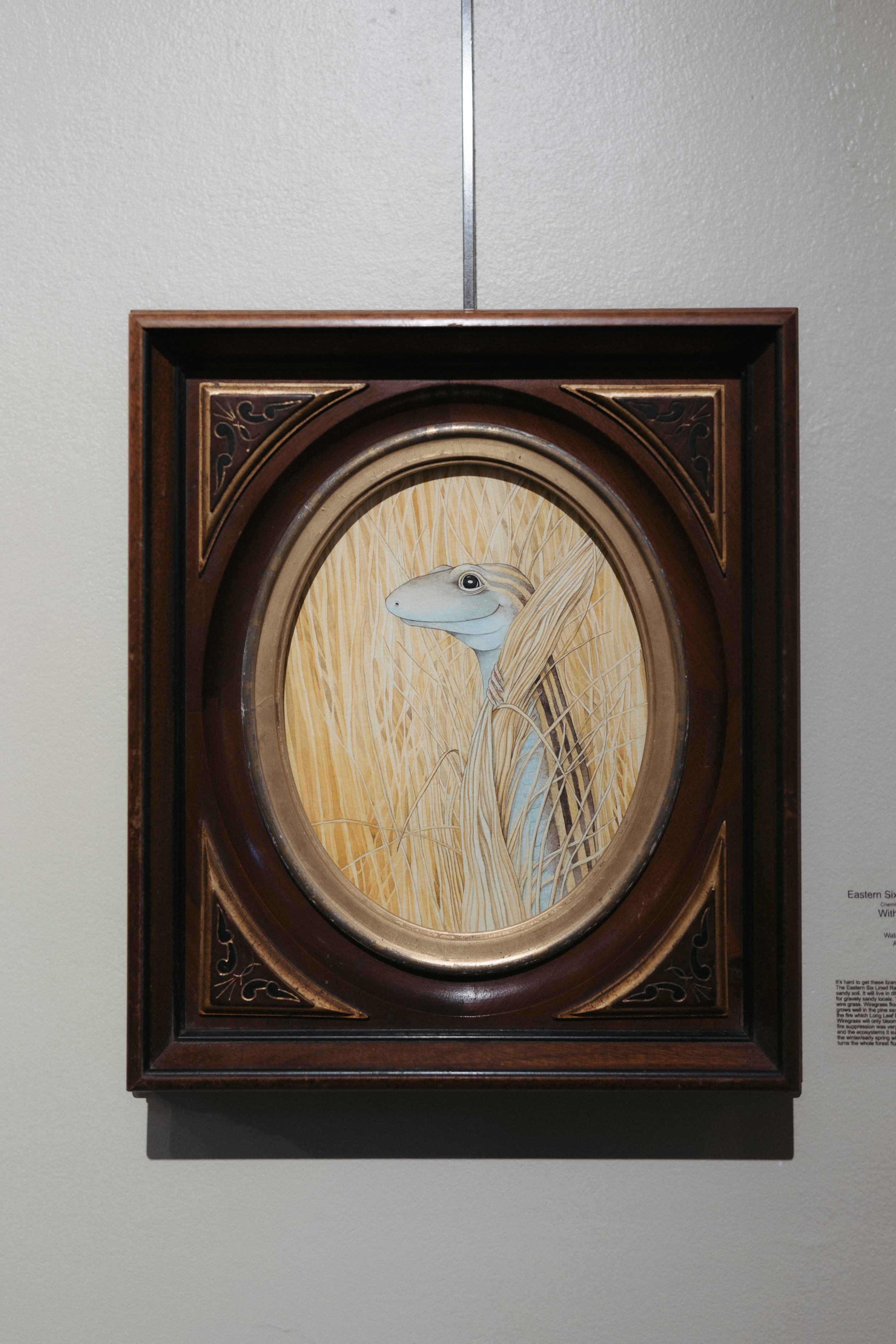
Each painting is framed in an antique frame! I sourced each frame, most of which are Victorian, from antique stores in NC and VA. The cohesive framing makes for a transformative and immersive show.

Each painting is framed in an antique frame! I sourced each frame, most of which are Victorian, from antique stores in NC and VA. The cohesive framing makes for a transformative and immersive show.
St. Francis Satyr Neonympha mitchellii francisci On Mitchell’s Sedge Carex mitchelliana This was a super special portrait session. I present- the St. Francis Satyr on its host plant the Mitchell’s Sedge. Why is this little brown butterfly so special? Because it only lives on Ft. Bragg in N.C. That’s it! Even more unique is the reason it’s habitat still exists, the artillery and military training exercises that take place keep and/or create the meadows this butterfly needs to live. There has also been less hunting of beavers on Ft. Bragg so the wetlands they create are still prevalent, which is also helpful. For the history buffs out there this butterfly is sporting a WWI era helmet from when Ft. Bragg (initially Camp Bragg) was started in 1918 as appropriately enough; an artillery camp! So for those of us whose windows rattle now and again as a result of Ft. Bragg, we can now thank those booms for keeping this little butterfly around! .
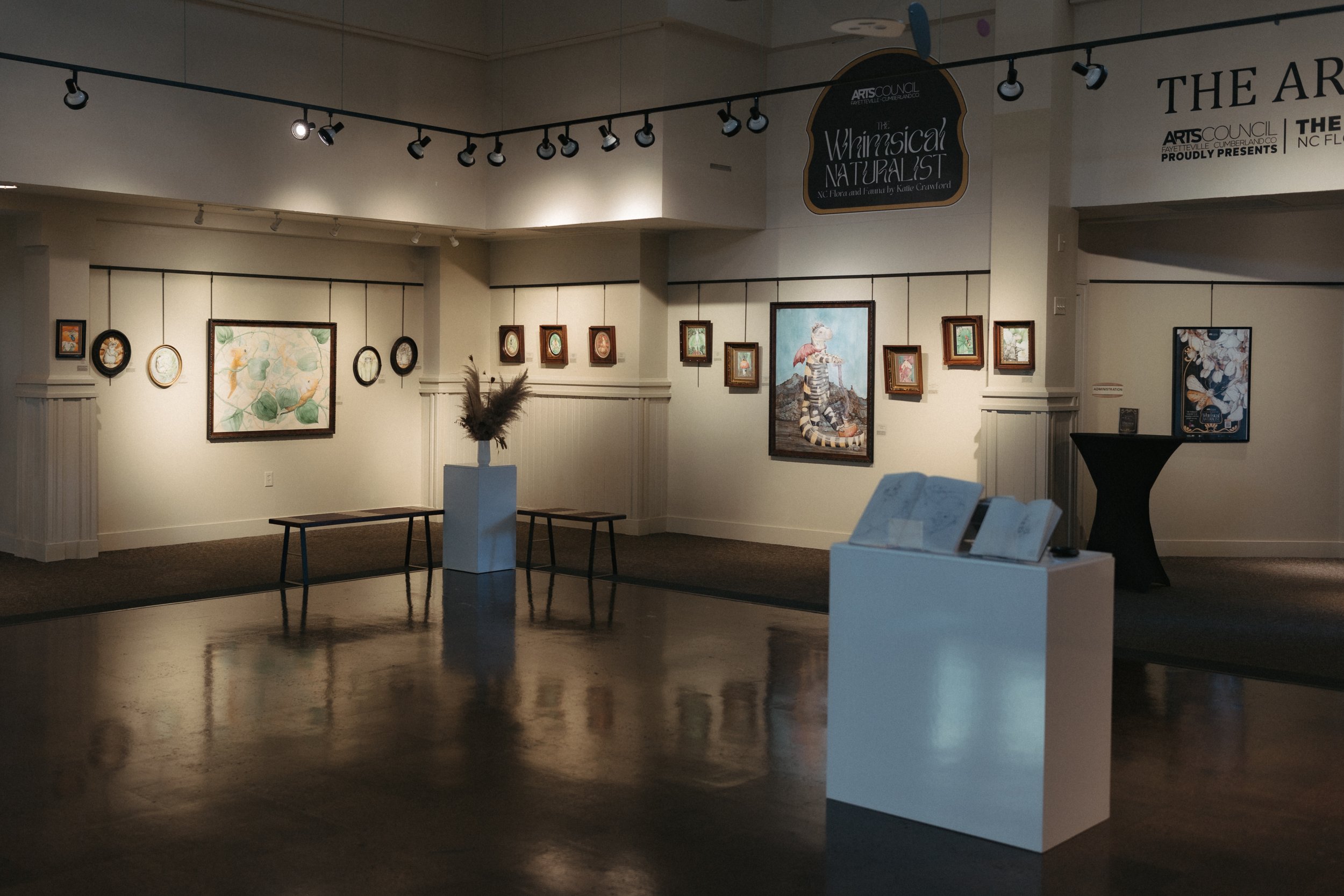
Each painting is framed in an antique frame! I sourced each frame, most of which are Victorian, from antique stores in NC and VA. The cohesive framing makes for a transformative and immersive show.
Green Anole Anolis carolinensis With Venus Fly Trap Dionaea muscipula Description Available
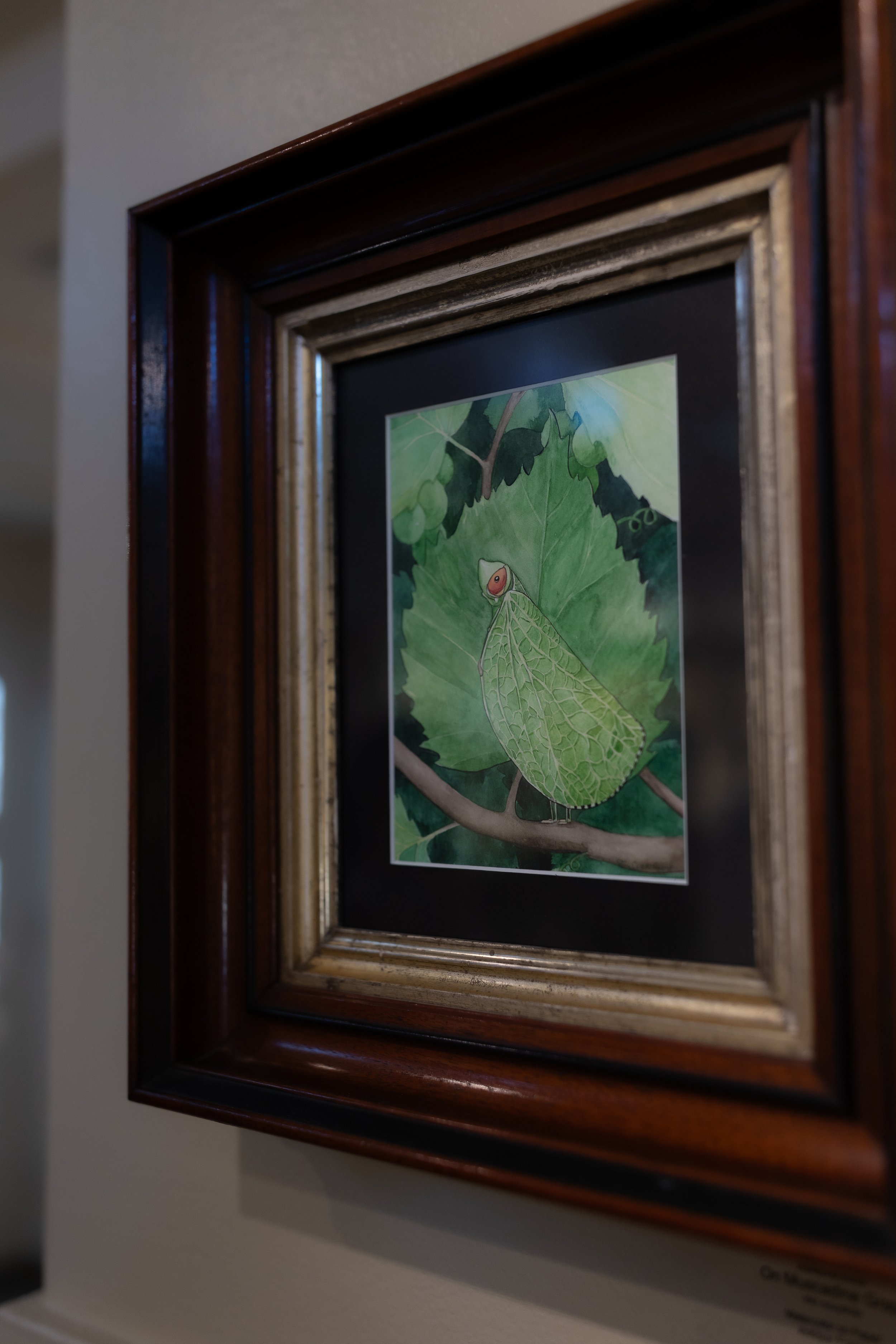
Each painting is framed in an antique frame! I sourced each frame, most of which are Victorian, from antique stores in NC and VA. The cohesive framing makes for a transformative and immersive show.
Red Salamander Pseudotriton ruber With False Caesar Mushrooms Amanita parcivolvata Description Available
Snapping Turtle Chelydra serpentina With American Lotus Nelumbo lutea Description Available
Ornate Chorus Frog Pseudacris ornata With Cinnamon Fern Osmundastrum cinnamomeum Description Available
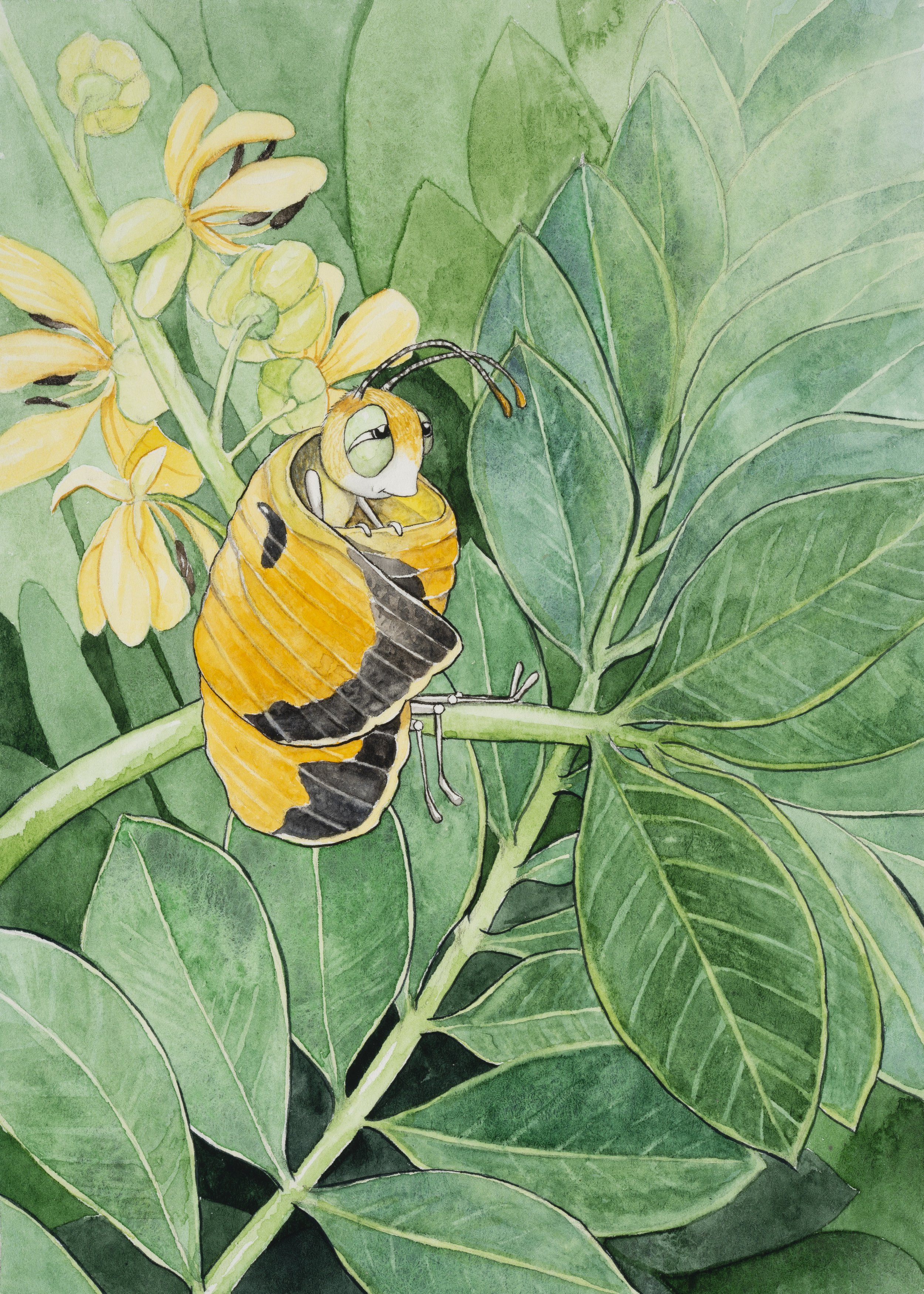
Sleepy Orange Butterfly Abaeis nicippe On The Wild Senna Cassia hebecarpa Description Available
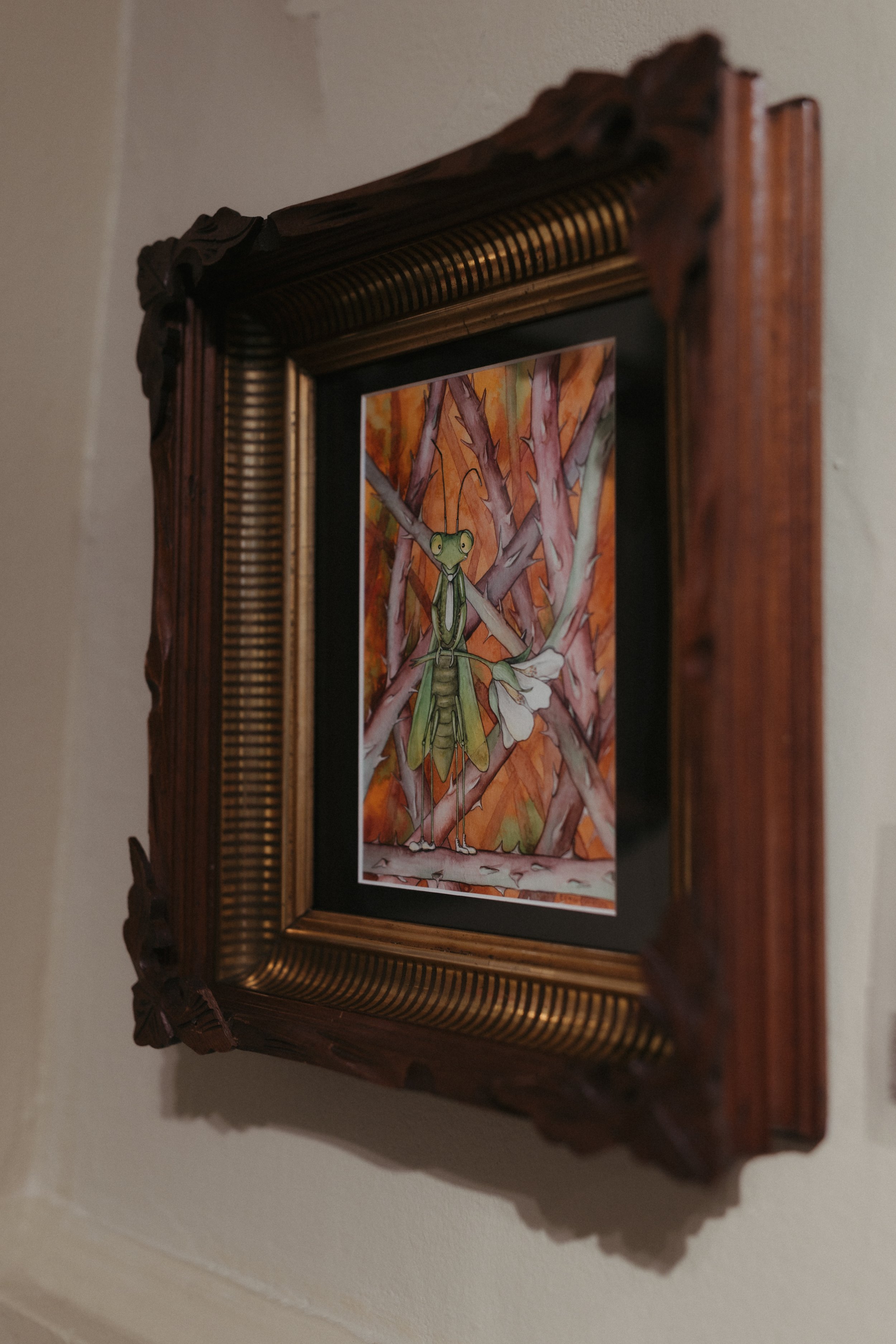
Each painting is framed in an antique frame! I sourced each frame, most of which are Victorian, from antique stores in NC and VA. The cohesive framing makes for a transformative and immersive show.
Eastern Box Turtle Terrapene carolina carolina With Dogwood Cornus florida The eastern box turtle is common across the state. It is the only terrestrial turtle in NC and is recognizable because of its ability to “box up” its shell for protection. They are mobile critters with homing instincts and establish ranges that include their favorite foods, hidey holes and meet up locations. They can live 25-30 years in the wild which puts them in danger from habitat fragmentation. This box turtle was showing me it’s favorite Flowering Dogwood tree. It was very proud to have NC’s state flower growing on its property. They told me dogwood flowers and rootbark were used as medicines by Native Americans, but to avoid the berries as they are toxic to people. The dogwood is an important part of the forest understory providing food for wildlife and improving soil quality because its leaves decompose quickly.
Rose Mallow Bee Ptilothrix bombiformis With Rose Mallow Flower Hibiscus moscheutos Description Available
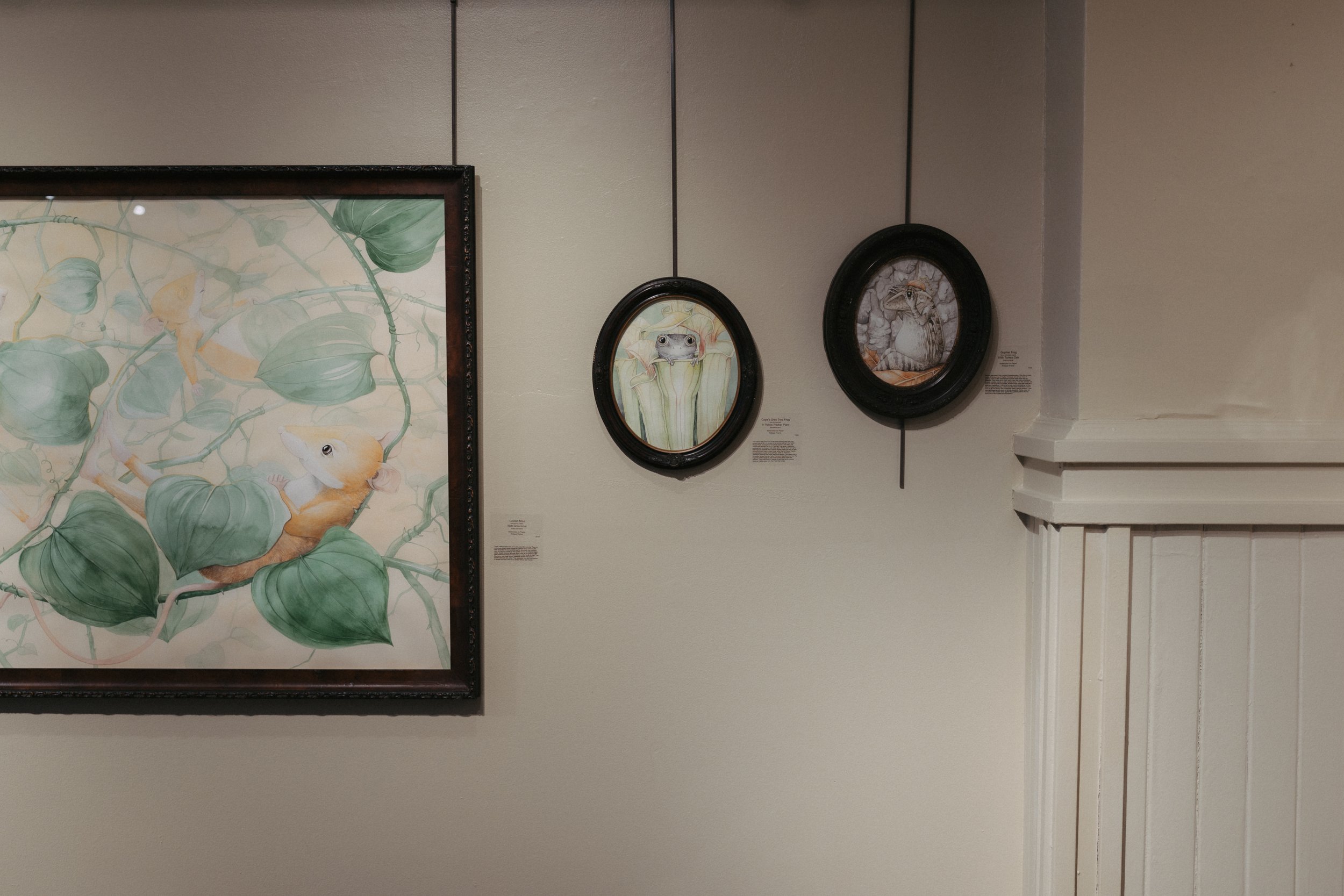
Each painting is framed in an antique frame! I sourced each frame, most of which are Victorian, from antique stores in NC and VA. The cohesive framing makes for a transformative and immersive show.
Red Ant Aphaenogaster Fulva With Blood Root Sanguinaria canadensis Description Available
Ground Skink Scincella lateralis With Dwarf Huckelberry Gaylussacia Dumosa Description Available
Blue Dasher Dragonfly Pachydiplax longipennis Swamp milkweed Asclepias incarnata Description Available
Carpenter Bee Xylocopa virginica On Passion Flower Passiflora incarnata Description Available
Holly Azure Celastrina idella On Bog Cheeto Senega lutea Description Available
Squash Bee Peponapis pruinose In Squash Flower family cucurbits (including acorn squash, summer and winter squash, gourds, and pumpkins) Description Available
